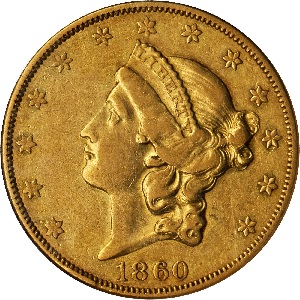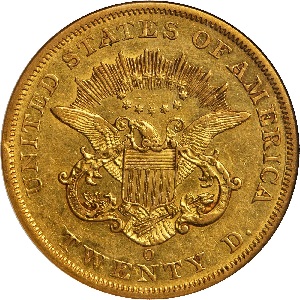1860-O Coronet $20 Double Eagle
The largest ever denomination released into circulation by the United States was the $20 double eagle. Legislation authorizing the double eagle was passed on March 3, 1849, shortly following the discovery of gold in California.(1)
The bill was originally written to begin making only a gold dollar coin, but was quickly amended to include the double eagle when the immensity of the discovery become clear.
The Coronet $20 double eagle was designed by Mint Engraver James B. Longacre. The obverse featured Liberty facing left, wearing a small crown called a coronet, inscribed with the word LIBERTY. Longacre modeled Liberty from the ancient Roman sculpture, Crouching Venus. The reverse was likened after the Great Seal of the United States, which had influenced U.S. coinage since 1797.(2)
1850 was the first year of mass production for the Coronet double eagle. After the first three years, double eagle production at the New Orleans mint slowed to a trickle. In 1854 and onward, much of the gold bullion that was previously shipped from California was being converted into coinage at the new San Francisco Mint.(3)
For numismatists, the years 1854-1861 are noted for the sequence of extremely rare $20 double eagles struck at New Orleans. The lack of bullion and structural issues at the facility explains the dearth of gold coinage during this period, all occurring in the shadow of a nation drifting toward civil war.
In 1860, the New Orleans Mint struck just 6,600 double eagles, the third lowest output of the antebellum era. Virtually all of them were released into circulation and vanished over time, leaving an extant population estimated at a meager 138 examples.(4)
Although very rare and desirable in any grade, the 1860-O double eagle is not the “show stopper” as are the 1854-O or 1856-O. Nevertheless, its value trends over the long haul are significantly far above average, just as one would expect from a coin of great rarity and historical legacy.
| Estimated survivors in all grades: 138 ?
The survivor estimate from PCGS represents an average of one or more experts' opinions as to how many examples survive of a particular coin in all grades. Survival estimates include coins that are raw, certified by PCGS, and certified by other grading services. Learn more at PCGS. |
| PCGS Rarity Scale: 7.6 ?
The 'PCGS CoinFacts Rarity Scale' assesses the relative rarity of all U.S. coins, based on estimated surviving examples. The scale runs from 1.0 to 10.0. The higher the number, the rarer the coin.
Learn more at PCGS. |
| Click HERE to check for availability on eBay** |
Preview of eBay selection:
 |
 |
| Trendline Avg = 13.90 | GOOD |
Historic Value Trend Charts:
| Last updated 10-9-24 | Return to Key Date Coin List | |
| Compare to Common Date Coin of Same Type | ||
|
|
||
| Download Charts to Your Computer | ||
Sources
1. Taxay, Don. The U.S. Mint and Coinage. New York, NY: Sanford J. Durst Numismatic Publications, 1966.
2. NGC. Liberty Head $20 (1850-1907).
3. Heritage Auctions. 1860-O $20 - Obverse Scratched - NGC Details. Aug 2018 Auction.
4. PCGS. 1860-O $20 (Regular Strike).
**Many very fine coin dealers sell on eBay. At any point in time, there may be over one million search results for United States coins. This includes quite a few of the recommendations on our Key Date Coin List.
If you’re thinking about purchasing a rare coin, eBay is certainly worth a look. For your convenience, the links from this site to eBay are coded to bring up only coins certified by PCGS and NGC.
As is always, always the case, never buy a valuable coin from a seller whose trustworthiness cannot be verified. Learn more about this at our chapter Best Places to Buy Coins, which also has a section on doing business on eBay.
In the interest of full disclosure, Rare Coins 101 receives a small commission anytime someone connects to eBay from this site and purchases something.
Coin images by Stack's Bowers Galleries.


